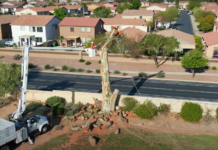The coming of the railroad without doubt revolutionized the economy of Arizona. Merchandise, such as farming supplies, coal and other products could now be hauled into the rapidly growing towns by rail, and local products, such as sheep, cattle, citrus, wheat and other products could be shipped to the East.
The Chinese was the largest group of immigrants to the West. Immigrants worked in a variety of trades, such as mining, small businesses, farming, ranching, and especially with the railroad. Southern Pacific Railroad hired 1,300 railroad employees for the hazardous task of extending the railroad through the Arizona desert in November of 1878.
Almost all of the employees were Chinese Americans (1,100) who worked long hours at $1 a day. These hard-working railroad men played a major part in the growth and development of the Southwest and certainly a tremendous role with the building of the railroad. They were able to lay more than a mile and a fourth of track per day that eventually connected the east coast with the west coast and made travel more comfortable, faster, efficient and economical during the 1800-1900s.
It took less than five months to lay tracks from Yuma to the Maricopa Summit, located 17 miles west of Maricopaville. After leaving Maricopa Summit, the tracks ran 785 feet to the top of a hill and, at that point, a five-mile curve began that is thought to be the longest continuous railroad curve in the world.
The government paid the railroad for each mile of track laid. Therefore, companies got more money for longer and less direct lines. In addition, they received more money from the towns reached.
The railroad reached Maricopaville in April of 1879 and by March 20, 1880, the line had been completed to Tucson.
Drawing by Maricopa High School Student Irac Mendez
Editor’s note: Maricopa factoids are a regular feature on InMaricopa.com. They are provided by the Maricopa Historical Society, a branch of the Friends of the Maricopa Public Library. Most of the photos and information come from “Reflections of a Desert Town” by author and historical society chairperson Patricia Brock.



![Shred-A-Thon to take place tomorrow An image of shredded paper. [Pixabay]](https://www.inmaricopa.com/wp-content/uploads/2024/03/shredded-paper-168650_1280-218x150.jpg)














![Shred-A-Thon to take place tomorrow An image of shredded paper. [Pixabay]](https://www.inmaricopa.com/wp-content/uploads/2024/03/shredded-paper-168650_1280-100x70.jpg)